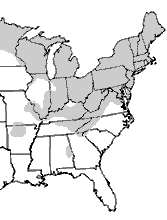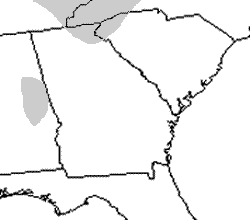Wood Frog (Rana [Lithobates] sylvatica)
![ransyl210 Wood Frog (Rana [Lithobates] sylvatica)](https://srelherp.uga.edu/wp-content/uploads/sites/70/2024/01/ransyl210.jpg)


Photos by Amanda Hurst unless otherwise noted
Description: The wood frog is small to medium sized frog with adults ranging from 1.5 to 2.75 in (3.7 – 7 cm). They have prominent dorsolateral folds that extend from near the vent to the head. Coloration is tan to brown with a blackish or brown mask extending from the snout to just below the tympanum, and a light stripe below it on the upper jaw. This is the only true frog in our region with such a mask.
Range and Habitat: Wood Frogs occur throughout most of northern North America even into parts of Alaska and the Yukon Territory. In the Western Hemisphere, they are the only cold-blooded tetrapod known to occur above the Artic Circle. In our region this species is restricted to the Appalachian Mountains in northern Georgia and northwestern South Carolina. Wood Frogs can be found in a variety of moist wooded habitats. They are among the most terrestrial frogs in our region and are often found far from water. They breed in fishless temporary wetlands and vernal pools and hibernate under stumps, leaves, and logs in wooded regions.
Habits: Wood frogs are active both at night and by day in wet weather. They feed on insects and other invertebrates. Wood Frogs are explosive breeders and breed early in the season, sometimes even before the ice melts. They attach their egg masses to vegetation that is below the water. The tadpoles undergo metamorphosis 40 to 90 days after hatching.
Call: The call of the wood frog is a short “quack.”
Conservation Status: Wood Frogs are common in our region and are not protected.
Account Author: Justin Neal, University of Georgia – revised by J.D. Willson, Katrina Ford, Lauren Maynor
